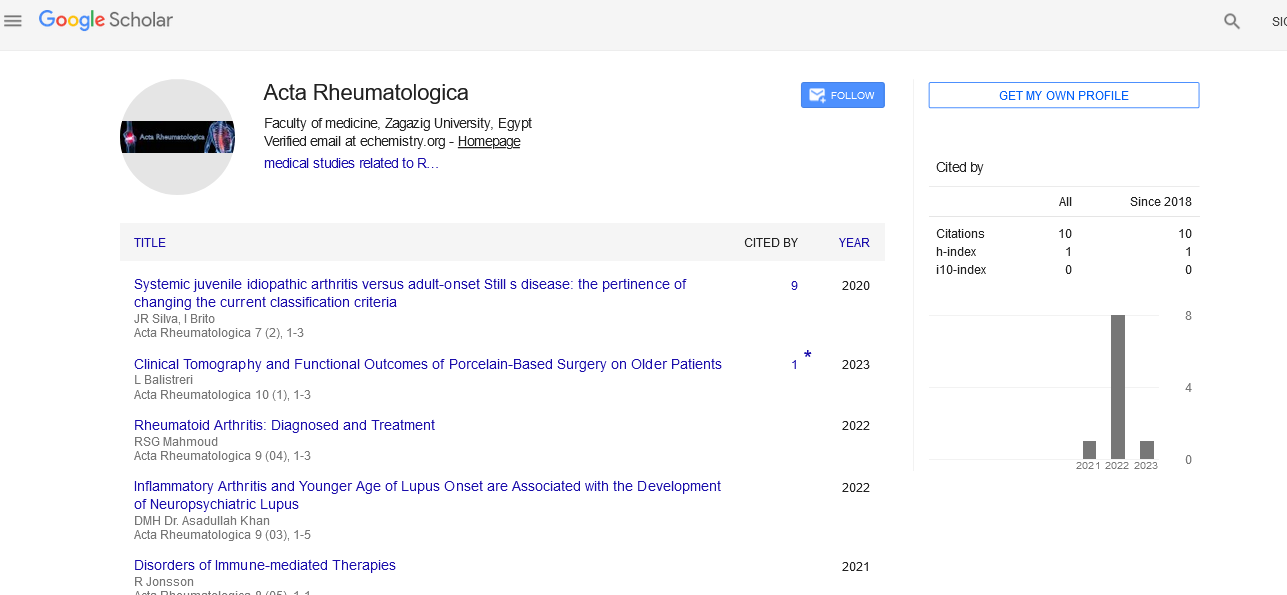Perspective - (2024) Volume 11, Issue 2
Pain Relief: Navigating the Pathways to Comfort and Well-being
Joanna Bonior*
Department of Rheumatology, Wroclaw Medical University, Wroclaw, Poland
*Correspondence:
Joanna Bonior, Department of Rheumatology, Wroclaw Medical University, Wroclaw,
Poland,
Email:
Received: 18-Mar-2024, Manuscript No. IPAR-24-14678;
Editor assigned: 21-Mar-2024, Pre QC No. IPAR-24-14678 (PQ);
Reviewed: 05-Mar-2024, QC No. IPAR-24-14678;
Revised: 15-Apr-2024, Manuscript No. IPAR-24-14678 (R);
Published:
22-Apr-2024
Introduction
Pain is a complex and often debilitating sensation that affects
millions of people worldwide, impacting their daily lives and
overall quality of life. Whether it's acute pain from an injury or
chronic pain stemming from a medical condition, finding
effective relief is a top priority for those who experience it. In
this comprehensive exploration of pain relief, we delve into the
various strategies, modalities, and approaches available to
alleviate discomfort and restore a sense of well-being.
Description
Understanding pain: Types, causes, and impact
Pain is a multifaceted sensory and emotional experience that
can manifest in different forms and intensities. It can result from
various causes, including injury, illness, inflammation, or nerve
damage, and can affect any part of the body. Acute pain typically
arises suddenly in response to tissue damage or injury and
serves as a protective mechanism, signaling the need for rest
and healing. In contrast, chronic pain persists for weeks, months,
or even years, often outlasting the initial injury or illness and
significantly impacting daily functioning and quality of life.
Approaches to pain relief: A multimodal approach
Pain relief encompasses a wide range of interventions aimed at
alleviating discomfort, improving function, and enhancing overall
well-being. These approaches can be broadly categorized into
pharmacological and non-pharmacological interventions, each
offering unique benefits and considerations. Pharmacological
treatments include over-the-counter medications such as
acetaminophen and ibuprofen, prescription opioids for severe
pain, and adjuvant medications such as antidepressants and
anticonvulsants. Non-pharmacological interventions encompass
physical therapy, acupuncture, massage therapy, Cognitive-
Behavioral Therapy (CBT), mindfulness-based techniques, and
complementary and alternative medicine modalities such as
herbal supplements and dietary changes.
Pharmacological interventions: Balancing efficacy
and safety
Pharmacological treatments play a central role in pain
management, offering relief from various types of pain and
discomfort. However, it's essential to balance the benefits of
pain relief with the potential risks and side effects associated
with medication use. Opioid analgesics, for example, can be
highly effective for acute pain and cancer-related pain but carry
a risk of dependence, addiction, and overdose when used longterm.
Nonsteroidal Anti-Inflammatory Drugs (NSAIDs) can help
reduce inflammation and relieve pain but may cause
gastrointestinal bleeding and cardiovascular complications with
prolonged use. Healthcare providers must carefully assess each
individual's needs and circumstances when prescribing
medications for pain relief, considering factors such as the type
and severity of pain, medical history, and risk of adverse effects.
Non-pharmacological approaches: Harnessing the
power of holistic healing
Non-pharmacological interventions offer alternative or
adjunctive strategies for managing pain and promoting overall
well-being. Physical therapy plays a crucial role in improving
mobility, strength, and flexibility, addressing underlying
musculoskeletal imbalances, and reducing pain. Modalities such
as acupuncture and massage therapy target specific trigger
points and muscle tension, promoting relaxation and reducing
stress. Psychological interventions, including Cognitive-
Behavioral Therapy (CBT) and Mindfulness-Based Stress
Reduction (MBSR), help individuals develop coping skills,
manage pain-related anxiety and depression, and improve
overall quality of life.
Integrative pain management: Blending conventional
and complementary approaches
Integrative pain management combines conventional medical
treatments with complementary and alternative therapies to
address the multifaceted nature of pain and promote holistic
healing. This approach recognizes that pain is influenced by
physical, emotional, social, and spiritual factors, and emphasizes
personalized care plans tailored to individual needs and
preferences. Integrative therapies may include nutritional
counseling, herbal supplements, yoga, meditation, biofeedback, and energy healing modalities such as Reiki and acupuncture. By
addressing the root causes of pain and enhancing the body's
innate healing capacity, integrative pain management offers a
comprehensive and patient-centered approach to pain relief and
well-being.
Emerging trends and innovations: Advancing the
science of pain relief
Advancements in pain research and technology continue to
drive innovation in the field of pain relief, offering new
approaches and modalities for managing pain effectively.
Regenerative medicine techniques, such as stem cell therapy
and Platelet-Rich Plasma (PRP) injections, hold promise for
promoting tissue repair and regeneration and reducing
inflammation in chronic pain conditions. Neuromodulation
devices, including spinal cord stimulators and peripheral nerve
stimulators, deliver targeted electrical stimulation to modulate
pain signals and provide relief for individuals with neuropathic
pain. Virtual reality therapy, cognitive training programs, and
mobile health apps offer novel approaches for distraction,
relaxation, and pain modulation, empowering individuals to take
an active role in managing their pain and improving their quality
of life.
Conclusion
Pain relief is a multifaceted journey that requires a
comprehensive, multimodal approach addressing physical,
emotional, and psychosocial aspects of well-being. By combining
evidence-based treatments with holistic healing modalities and
embracing emerging innovations, individuals can find relief from
pain and reclaim their vitality and joy. Through collaboration
with healthcare providers, support from loved ones, and a
commitment to self-care and resilience, individuals can
transcend the limitations of pain and embark on a path towards
healing and thriving. Whether it's through medication, physical
therapy, mindfulness practices, or cutting-edge technologies,
there is hope and help available for those seeking relief from
pain, enabling them to live life to the fullest.
Citation: Bonior J (2024) Pain Relief: Navigating the Pathways to Comfort and Well-being. Acta Rheuma Vol:11 No:2





